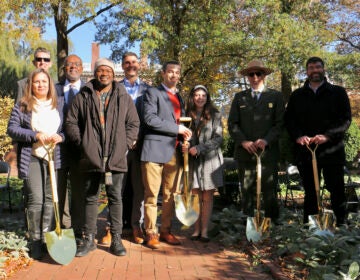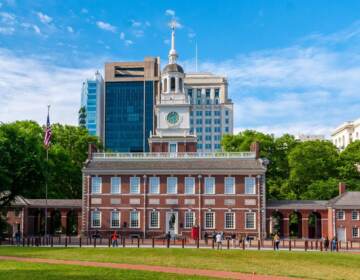Benjamin Rush Garden re-opens with a gift from the late Queen Elizabeth II
The Benjamin Rush Garden in Independence National Historic Park has been redesigned with England in mind.
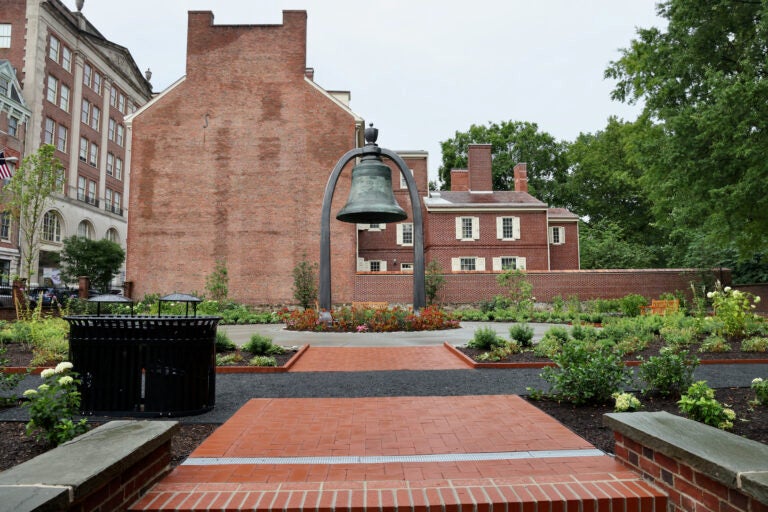
The Benjamin Rush Garden at Third and Walnut streets was rehabilitated to become home to the Bicentennial Bell. (Emma Lee/WHYY)
From Philly and the Pa. suburbs to South Jersey and Delaware, what would you like WHYY News to cover? Let us know!
When the British Consul General arrived at 3rd and Walnut streets on a drizzly Friday morning for a ribbon cutting of the newly imagined Benjamin Rush Garden, she felt right at home.
Not only is the garden dominated by a bell donated in 1976 by Queen Elizabeth II, but the sky was gray and wet as English tea.
“I wouldn’t be a British diplomat if I didn’t start by paying tribute to the wonderful British weather that we brought with us today,” Hannah Young joked to the crowd gathered under umbrellas. “Great for the garden. We’ll claim this one. You’re welcome.”
The garden is part of Independence National Historical Park at the site of the home of Dr. Benjamin Rush, the father of American psychiatry and signer of the Declaration of Independence. The old garden was ripped out last winter and redesigned to accommodate the Bicentennial Bell. The original bell tower built for the Queen’s gift was demolished in 2013 to make way for the Museum of the American Revolution. The bell has been in storage ever since.
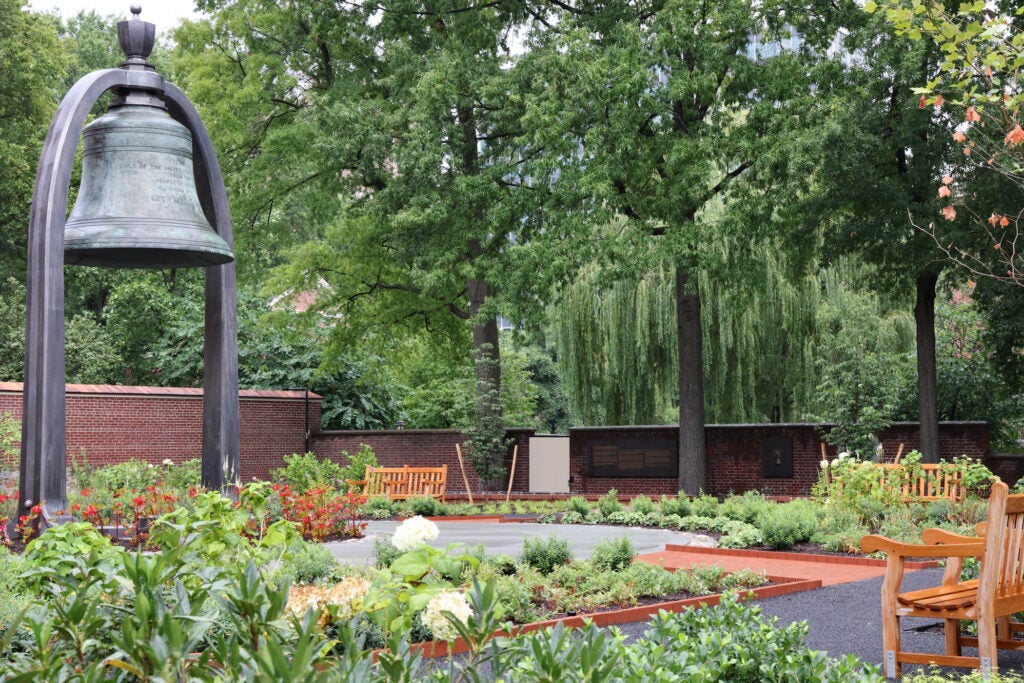
The bell is now suspended about 15 feet in the air, encircled by plants representing the British and American relationship. Landscape designer Bryan Hanes sought out foliage that would have been traded between the two countries in the 18th and 19th centuries, such as flowering hydrangea shrubs from the New World and hypericum (St. John’s Wort) from the Old World.
“When people came over from the Old World, they came across all these plants in the forests that were new to them and they got excited about it,” Hanes said. “They’d send them back to friends and family, and it started this horticultural tradition.”
London planetrees, a hybrid of American and Old World sycamores, border the garden along 3rd and Walnut Streets.
National Park Service superintendent Steve Sims said the garden looks better than it ever has.
“It’s a dramatic change, to the positive,” Sims said. “The landscaping that was here before wasn’t maintained, didn’t have an irrigation system, lots of weeds. It just wasn’t the type of space that reflects well on Dr. Benjamin Rush.
The garden is open to the public. Still to come are interpretive signs that will point out the story of the bell and the relationship between the United States and England.
Interpretations of the new garden varied even on its opening day.
At the ribbon cutting ceremony, Sims remarked on Dr. Benjamin’s Rush’s interest in the medicinal values of plants. Independence Historic Trust board chair Bill Marrazzo (who is also CEO of WHYY) had the city’s waterways on his mind: the former head of the Philadelphia Water Department spoke of Dr. Rush’s pioneering public health actions when he re-routed nearby Dock Creek to eradicate mosquito-borne diseases.
State Sen. Nikil Saval looked at the phrase inscribed on the Bicentennial Bell, “Let Freedom Ring,” and noted its use in social justice causes, particularly in Dr. Martin Luther King, Jr.’s “I Have a Dream” speech at the 1963 March on Washington.
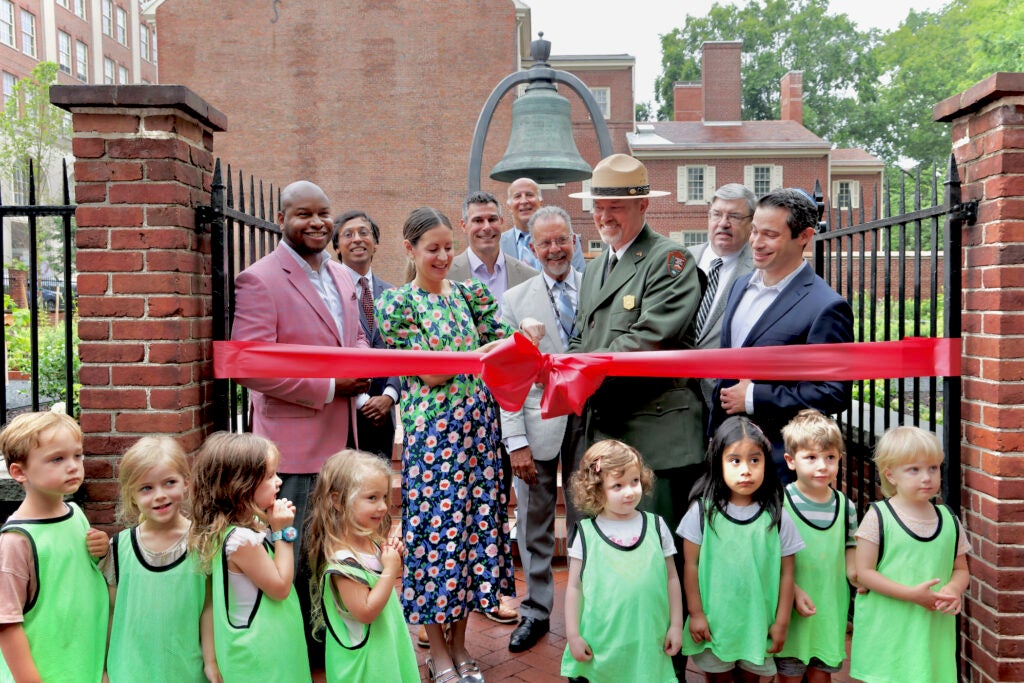
Joseph Glyn, director of the Landenberger Family Foundation, which funded the garden redesign, felt an urgency to protect the ideals of democracy.
“We may be consumed by petty differences. We may be disheartened when it seems that democracy is on the defensive,” Glyn said. “Like this bell in storage since 2013, the ideals and history of our Revolution are sometimes missing from the public view. That’s why we were thrilled to help bring the bell and its enduring message back to the public.”
However visitors approach the garden and the bell, Superintendent Sims hopes they will use it as a contemplative space.
“At the National Park Service, we can talk about what’s important all day long,” he said. “But it’s really the visitor that determines what’s relevant,” he said.

Get daily updates from WHYY News!
WHYY is your source for fact-based, in-depth journalism and information. As a nonprofit organization, we rely on financial support from readers like you. Please give today.



